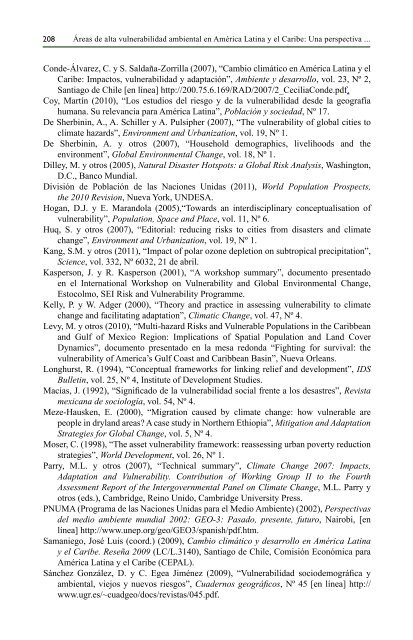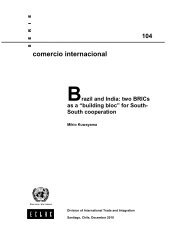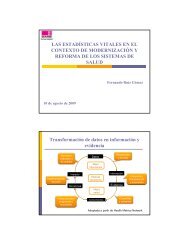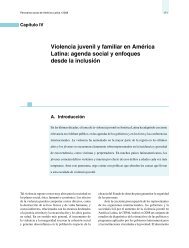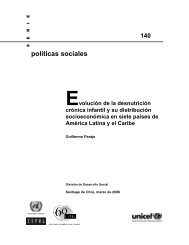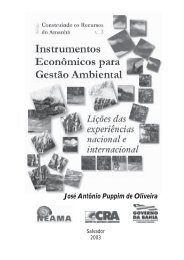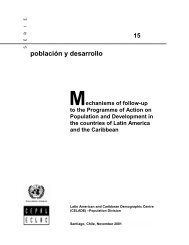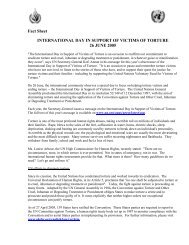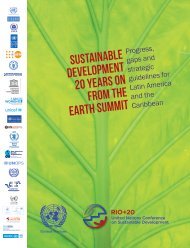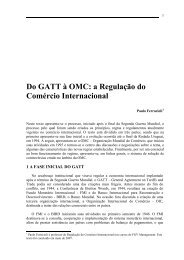Documento en formato pdf (3694 kb) - Cepal
Documento en formato pdf (3694 kb) - Cepal
Documento en formato pdf (3694 kb) - Cepal
You also want an ePaper? Increase the reach of your titles
YUMPU automatically turns print PDFs into web optimized ePapers that Google loves.
208 Áreas de alta vulnerabilidad ambi<strong>en</strong>tal <strong>en</strong> América Latina y el Caribe: Una perspectiva ...<br />
Conde-Álvarez, C. y S. Saldaña-Zorrilla (2007), “Cambio climático <strong>en</strong> América Latina y el<br />
Caribe: Impactos, vulnerabilidad y adaptación”, Ambi<strong>en</strong>te y desarrollo, vol. 23, Nº 2,<br />
Santiago de Chile [<strong>en</strong> línea] http://200.75.6.169/RAD/2007/2_CeciliaConde.<strong>pdf</strong>.<br />
Coy, Martín (2010), “Los estudios del riesgo y de la vulnerabilidad desde la geografía<br />
humana. Su relevancia para América Latina”, Población y sociedad, Nº 17.<br />
De Sherbinin, A., A. Schiller y A. Pulsipher (2007), “The vulnerability of global cities to<br />
climate hazards”, Environm<strong>en</strong>t and Urbanization, vol. 19, Nº 1.<br />
De Sherbinin, A. y otros (2007), “Household demographics, livelihoods and the<br />
<strong>en</strong>vironm<strong>en</strong>t”, Global Environm<strong>en</strong>tal Change, vol. 18, Nº 1.<br />
Dilley, M. y otros (2005), Natural Disaster Hotspots: a Global Risk Analysis, Washington,<br />
D.C., Banco Mundial.<br />
División de Población de las Naciones Unidas (2011), World Population Prospects,<br />
the 2010 Revision, Nueva York, UNDESA.<br />
Hogan, D.J. y E. Marandola (2005),“Towards an interdisciplinary conceptualisation of<br />
vulnerability”, Population, Space and Place, vol. 11, Nº 6.<br />
Huq, S. y otros (2007), “Editorial: reducing risks to cities from disasters and climate<br />
change”, Environm<strong>en</strong>t and Urbanization, vol. 19, Nº 1.<br />
Kang, S.M. y otros (2011), “Impact of polar ozone depletion on subtropical precipitation”,<br />
Sci<strong>en</strong>ce, vol. 332, Nº 6032, 21 de abril.<br />
Kasperson, J. y R. Kasperson (2001), “A workshop summary”, docum<strong>en</strong>to pres<strong>en</strong>tado<br />
<strong>en</strong> el International Workshop on Vulnerability and Global Environm<strong>en</strong>tal Change,<br />
Estocolmo, SEI Risk and Vulnerability Programme.<br />
Kelly, P. y W. Adger (2000), “Theory and practice in assessing vulnerability to climate<br />
change and facilitating adaptation”, Climatic Change, vol. 47, Nº 4.<br />
Levy, M. y otros (2010), “Multi-hazard Risks and Vulnerable Populations in the Caribbean<br />
and Gulf of Mexico Region: Implications of Spatial Population and Land Cover<br />
Dynamics”, docum<strong>en</strong>to pres<strong>en</strong>tado <strong>en</strong> la mesa redonda “Fighting for survival: the<br />
vulnerability of America’s Gulf Coast and Caribbean Basin”, Nueva Orleans.<br />
Longhurst, R. (1994), “Conceptual frameworks for linking relief and developm<strong>en</strong>t”, IDS<br />
Bulletin, vol. 25, Nº 4, Institute of Developm<strong>en</strong>t Studies.<br />
Macías, J. (1992), “Significado de la vulnerabilidad social fr<strong>en</strong>te a los desastres”, Revista<br />
mexicana de sociología, vol. 54, Nº 4.<br />
Meze-Hausk<strong>en</strong>, E. (2000), “Migration caused by climate change: how vulnerable are<br />
people in dryland areas? A case study in Northern Ethiopia”, Mitigation and Adaptation<br />
Strategies for Global Change, vol. 5, Nº 4.<br />
Moser, C. (1998), “The asset vulnerability framework: reassessing urban poverty reduction<br />
strategies”, World Developm<strong>en</strong>t, vol. 26, Nº 1.<br />
Parry, M.L. y otros (2007), “Technical summary”, Climate Change 2007: Impacts,<br />
Adaptation and Vulnerability. Contribution of Working Group II to the Fourth<br />
Assessm<strong>en</strong>t Report of the Intergovernm<strong>en</strong>tal Panel on Climate Change, M.L. Parry y<br />
otros (eds.), Cambridge, Reino Unido, Cambridge University Press.<br />
PNUMA (Programa de las Naciones Unidas para el Medio Ambi<strong>en</strong>te) (2002), Perspectivas<br />
del medio ambi<strong>en</strong>te mundial 2002: GEO-3: Pasado, pres<strong>en</strong>te, futuro, Nairobi, [<strong>en</strong><br />
línea] http://www.unep.org/geo/GEO3/spanish/<strong>pdf</strong>.htm.<br />
Samaniego, José Luis (coord.) (2009), Cambio climático y desarrollo <strong>en</strong> América Latina<br />
y el Caribe. Reseña 2009 (LC/L.3140), Santiago de Chile, Comisión Económica para<br />
América Latina y el Caribe (CEPAL).<br />
Sánchez González, D. y C. Egea Jiménez (2009), “Vulnerabilidad sociodemográfica y<br />
ambi<strong>en</strong>tal, viejos y nuevos riesgos”, Cuadernos geográficos, Nº 45 [<strong>en</strong> línea] http://<br />
www.ugr.es/~cuadgeo/docs/revistas/045.<strong>pdf</strong>.


